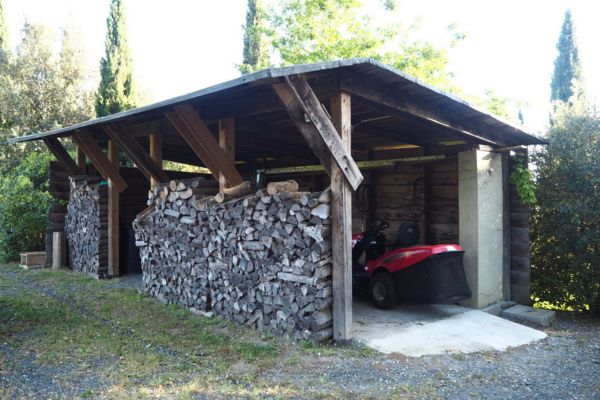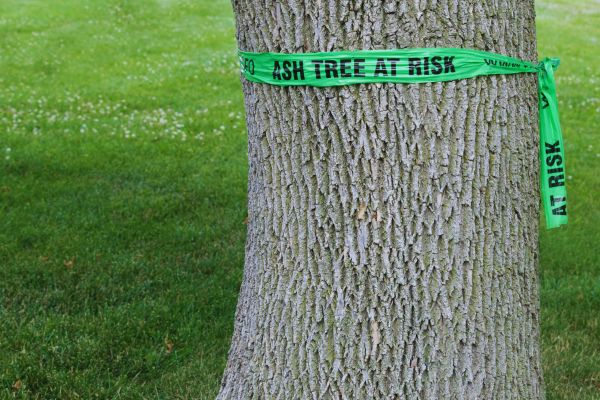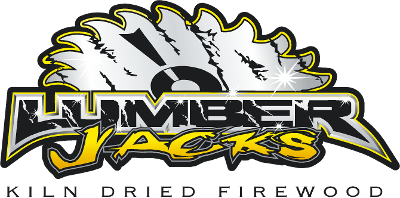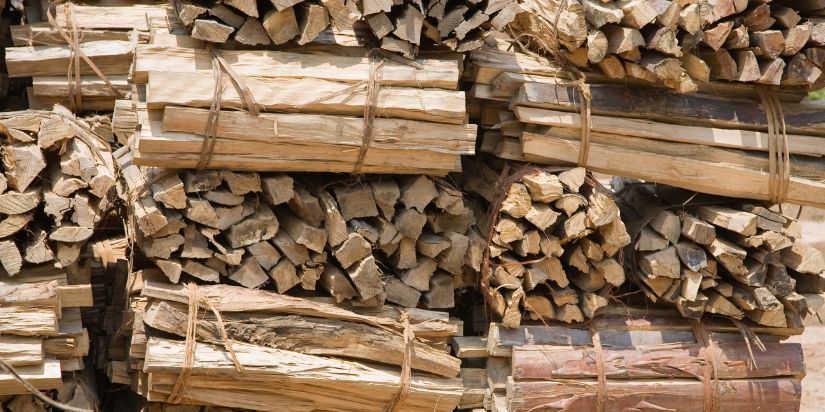Firewood bundles are a convenient, easy-to-transport option that doesn’t require a lot of home storage – or, sometimes, any home storage. But are they the right choice for you?
If you have questions about firewood bundles and their alternatives, you’ve come to the right place. Below, we take a deep dive into some of your most common questions on the topic to help you make an informed purchasing decision.
But before you delve in, take a moment to learn about the kiln-dried firewood Lumberjacks offers by clicking the button below. We offer various firewood purchasing options, including bundles, to our customers in Woodstock, Lake in the Hills and throughout the Chicago suburbs.
How much Woodstock firewood is in a bundle?
There’s no industry standard for how much firewood comes in a bundle. However, most companies will include seven to 12 logs between 12 and 18 inches long each. Often, this amounts to roughly one cubic foot of wood but can be a little more or less depending on the company you use.
What uses are firewood bundles enough wood for?
Firewood bundles are an excellent choice for a small fire, whether in a pit outside or a fireplace. If you choose high-quality wood, a single bundle should fuel your fire for an hour or two. We recommend purchasing two to three bundles at once when you want to burn a single fire for a little longer.
Firewood bundles are also an excellent option for camping. If you’re only going to have a fire at night, one to two bundles per night should be plenty. If you also plan to use your fires to cook, we recommend three to four bundles daily. The benefit of bundles is that they’re easier to transport on your camping trip.
When are firewood bundles not enough wood?
Firewood bundles are great for many situations but aren’t always the best choice. Examples of when firewood bundles aren’t enough wood include:
- When using firewood as a primary or secondary heating source for your home
- For large bonfires with long burning times
- For small fires regularly
Basically, if you need any amount of wood regularly, it makes more sense to purchase more at once. Of course, this also requires you to have proper storage for your firewood at home.
What purchasing options are available besides firewood bundles?
At Lumberjacks, we offer the following purchasing options in addition to our firewood bundles:
- ¼ Face Cord—Measures four feet by two feet. Only available for pickup and fits easily in a car trunk. Perfect for sporadic fireplace usage or occasional fires throughout a single season.
- ½ Face Cord—Measures four feet by four feet. It may fit in the bed of full-sized trucks, but you may want to choose delivery instead. A great choice for using firewood sporadically but wanting to stay stocked up.
- Full Face Cord—Measures four feet by eight feet. You will need delivery because it won’t fit into any standard vehicle. An excellent option for regular usage, such as when you use firewood as your primary or secondary heating source.
How should I store my firewood after I’ve bought it?
If you purchase firewood bundles, it’s not usually necessary to store them because they’re created for a single use. However, understanding firewood storage best practices is crucial if you plan to buy more at once.
After purchasing firewood, store it in a dry, well-ventilated area away from the ground to prevent moisture buildup and pest infestation. Ideally, use a woodshed or stack the wood on pallets and cover it with a tarp to protect it from rain and snow.
Ensure the storage area is away from the house to reduce fire risks and allow airflow around the wood to aid in drying and maintaining its quality. Regularly check for signs of mold or insects and promptly address any issues to preserve the firewood for efficient burning.

This woodshed is perfectly built to allow ample airflow and easy access.
What’s the difference between green, seasoned and kiln-dried firewood?
To keep it short, the primary difference between green, seasoned and kiln-dried firewood is how it’s dried. Here are more detailed answers about each type of firewood:
Green Firewood
Green firewood refers to freshly cut wood that has not undergone any drying process. It typically contains a high moisture content, often around 50% or more. Burning green wood can be inefficient because a significant amount of energy evaporates the water rather than producing heat. It also tends to create more creosote buildup in chimneys, which can be a fire hazard.
Seasoned Firewood
Seasoned firewood is allowed to dry naturally for an extended period, usually six months to a year or more. During this time, the moisture content decreases to around 20-25%, making it easier to ignite and burn more efficiently.
Seasoned wood produces more heat and less smoke than green wood. You can identify it by its lighter weight, cracks or splits on the ends, and a hollow sound when two pieces are knocked together. While seasoned wood is vastly superior to green wood, it’s also prone to bug infestations and mold.
Kiln-Dried Firewood
Kiln-dried firewood is dried in a controlled environment using a kiln set to a specific temperature. This process accelerates the drying time to as little as a few days and purifies the wood from bugs, chemicals, mold and other undesirables. This type of firewood burns hotter and cleaner than green or seasoned options because of its low moisture content, which is guaranteed to be below 20%.
Kiln-dried wood is considered a premium product, and with good reason. It’s more efficient, creates less creosote and provides a more consistent burning experience than the alternatives.
Are hardwoods or softwoods the better firewood choice?
Hardwoods are by far the better firewood choice for many reasons. These options produce less creosote, leading to better air quality than if using softwoods. Hardwoods are also much denser, leading to longer, more robust fires that allow you to maximize your purchase.
Are there any types of firewood I should avoid buying or burning?
Yes, you should avoid buying or burning several types of firewood. As discussed above, green and seasoned options aren’t recommended. Other examples include:
- Softwoods with high resin content: These options produce a lot of sticky sap and include things like pine, cedar and spruce.
- Processed wood: You should never burn wood that has been chemically treated or painted, as it can release harmful substances into the air.
- Contaminated wood: Don’t burn anything that shows signs of mold, mildew or fungus and avoid wood that’s been sprayed with chemicals.
- Poisonous plants: Avoid burning or buying anything with poisonous properties or contaminated with such, including oleander, poison oak, poison ivy and poison sumac.
Purchasing kiln-dried firewood bundles can save you from this hassle. Thanks to the low moisture content and purification process, it is guaranteed not to have these issues if purchased from a reputable distributor like Lumberjacks.
Are there regulations or restrictions on transporting firewood?
Yes. The regulations and restrictions on transporting firewood vary from one state to the next. If you plan to take firewood across state lines, it’s crucial you investigate the latest laws and warnings. Our Illinois customers can find information on these regulations on the Illinois Department of Agriculture’s website.
As of July 2024, Illinois is under a federally regulated quarantine for the Emerald Ash Borer, an invasive species native to Asia. This beetle attacks ash trees and could wipe this species from North America if not controlled.

The Emerald Ash Borer has damaged this ash tree, which is now at risk of death.
A federal quarantine means you can’t transport wood over state lines, and anything cut in Illinois must remain here unless very specific circumstances are met. Kiln-drying the firewood is one of the four mitigation measures the USDA approves for transportation.
How much do firewood bundles cost?
The cost of firewood bundles can vary significantly based on numerous factors. Examples of considerations include the drying method used, environmental practices, sorting methods and location, to name a few.
Is it more cost-efficient to purchase firewood in bulk?
Whether it’s more cost-efficient to purchase firewood bundles or in bulk depends on your needs. We recommend bulk purchases for customers who regularly use large amounts of firewood. Otherwise, firewood bundles (or perhaps ¼ face cords) should be enough and purchasing more could be wasteful.
Do companies deliver firewood bundles?
At Lumberjacks, we don’t deliver our firewood bundles or ¼ face cords. However, we do provide delivery for our half and full-face cords.
Delivery isn’t often an option for bundles because they’re so small. The gas it costs to deliver would be more than the cost of the bundle. Thankfully, you’ll have no issue fitting a firewood bundle into your vehicle.
Where can I buy kiln-dried firewood bundles?
Lumberjacks sells high-quality kiln-dried firewood bundles, ¼ face cords, ½ face cords and full face cords from our convenient Illinois locations in Woodstock and Lake in the Hills. Our company prides itself on always going above and beyond for our customers, as evident in our numerous positive reviews.
What if I have more questions about firewood bundles?
If you still have questions about firewood bundles, we recommend checking out the firewood FAQs on our website. Of course, you can always call us to speak with a firewood expert. We’re happy to answer your questions!
Premium Kiln-Dried Firewood Bundles in Woodstock, IL
Ready to purchase premium kiln-dried firewood bundles in Woodstock, Lake in the Hills or the surrounding region? Call us today or contact us online to place your order. We look forward to providing you with high-quality firewood, top-notch customer service and no-hassle firewood delivery!









